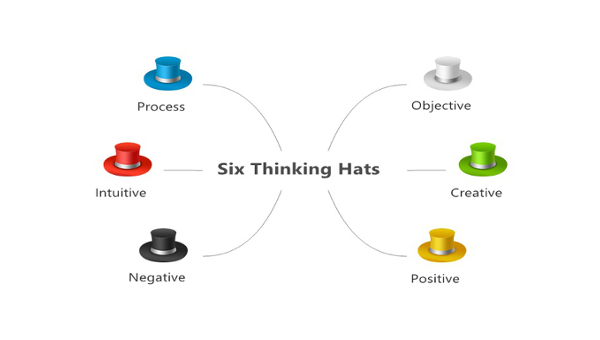Entrepreneurs are already known for having to wear a lot of hats in business — often times, a single business owner will act as the sales and marketing department, accounting department, and IT department on top of everything else they need to do to help their business thrive. There is no question that it can be stressful to juggle so many duties… but wearing multiple hats can be beneficial when it comes to decision making.
The 6 Thinking Hats Approach
Conceived by Edward de Bono in his book, “Six Thinking Hats,” the concept is about looking at a decision from different perspectives. In this approach, each perspective is assigned a different colored hat. During the decision making process, one considers each alternative while wearing each colored hat. The approach also works in a group setting, where members of the group can take (or be assigned) a different perspective to analyze the benefits and disadvantages of a particular choice.
The six hats and their meanings are as follows:
White: The factual approach. Focus on what information you have and what information you are missing. Spot the trends and patterns from the available data.
Yellow: The optimistic approach. Keep your thoughts focused on the positive. What benefits are to be gained? What is the best-case scenario? Find the value in choosing that particular option.
Black: The pessimistic approach. This entails becoming the devil’s advocate, of sorts. Where are the gaps in the proposed alternative? What could go wrong? Look for the potential difficulties and what dangers might lie ahead, but beware of wearing this hat for too long as it can lead to inaction.
Red: The emotional approach. With this hat on one speaks freely, does no hesitate to say what they feel and “goes with their gut”. This is the hat that embraces intuition, love, hate, fear, and whatever else one may be feeling about a solution.
Green: The creative approach. Look for new insights and alternatives. What haven’t you considered yet? At the risk of sounding cliché, think outside the box.
Blue: The controlled approach. While wearing this hat, make sure that the guidelines for the other hats are being observed. Put everything together and evaluate spots where you might need to revisit the idea wearing a particular hat. If multiple people are participating, you might use the blue hat to keep everyone else on track.
Generally, any decision-making session using this approach should start and end with a blue hat. One recommended sequence is Blue, Red, White, Yellow, Black, Green, Blue. However, bear in mind that you may find another sequence that works more effectively based on the question, your own strengths/weaknesses …or those of your group.
The 6 Thinking Hats approach works well because it encourages you to think in ways you wouldn’t normally. It requires to you to think from varying angles, most likely a few that are not inherent to your particular way of normal decision making. You may be more the logical type, or the optimistic type, but in both cases, considering other approaches broadens and enriches your thinking about the decision. More options generally leads to better decisions. In group settings, the thinking hats approach can help defuse conflict in situations where people would normally disagree because of their different perspectives — instead, it turns those differences into an asset and can result in better “buy-in” once a decision has been made.
